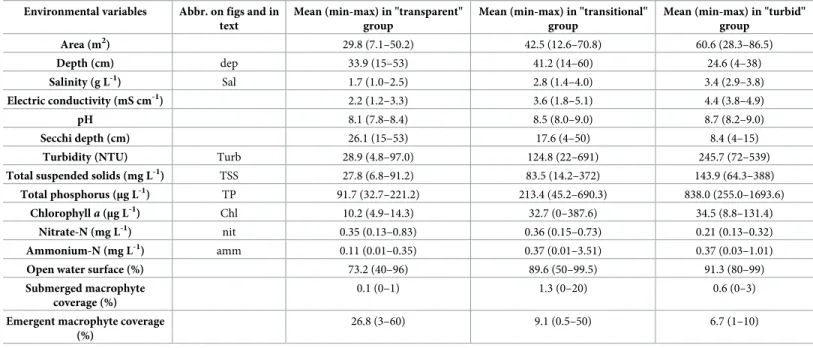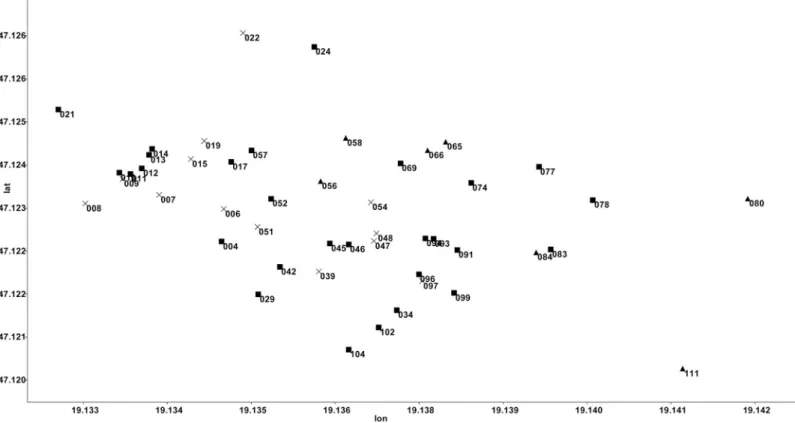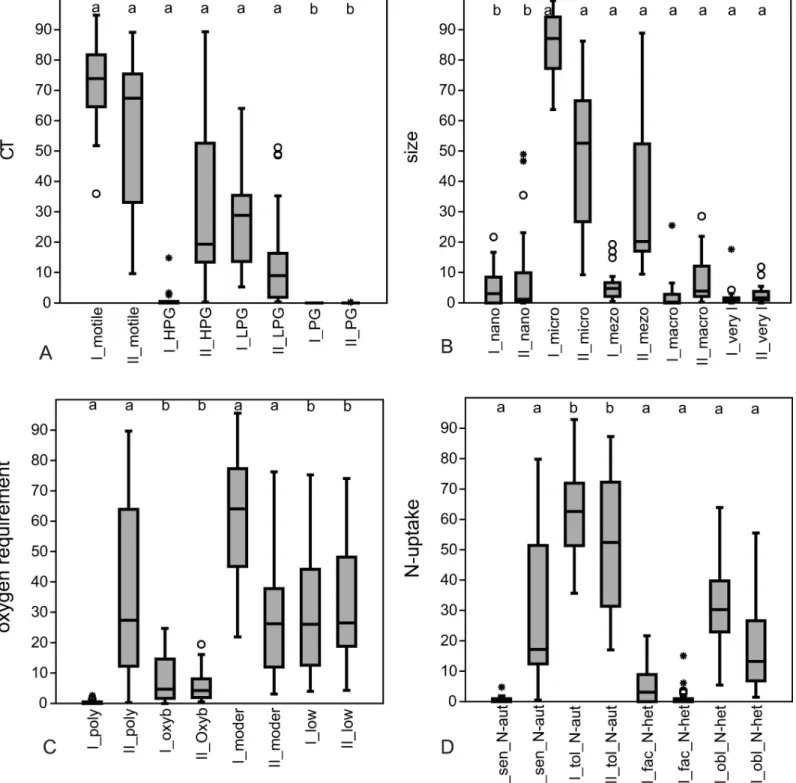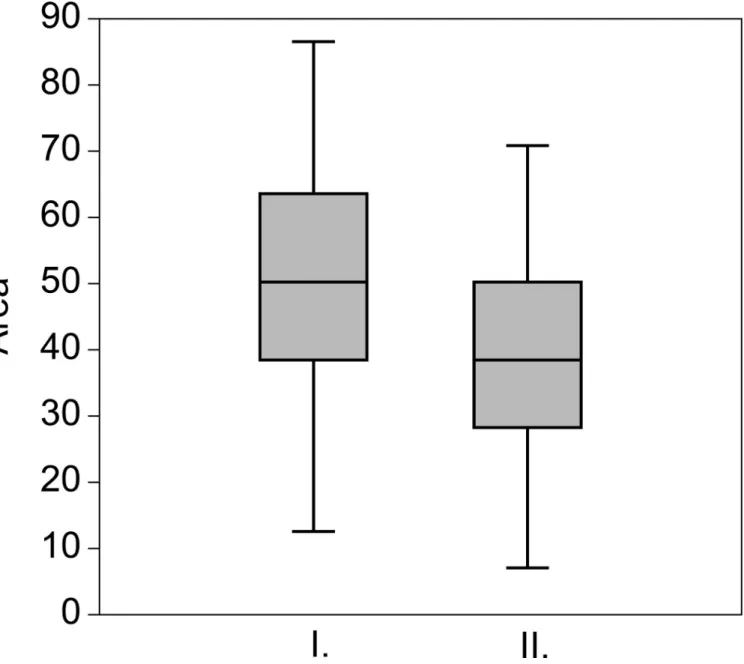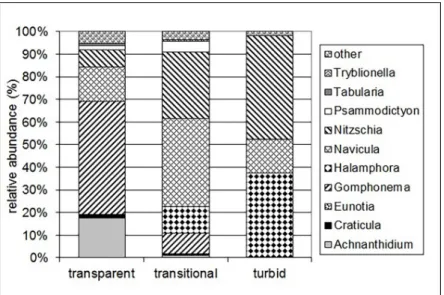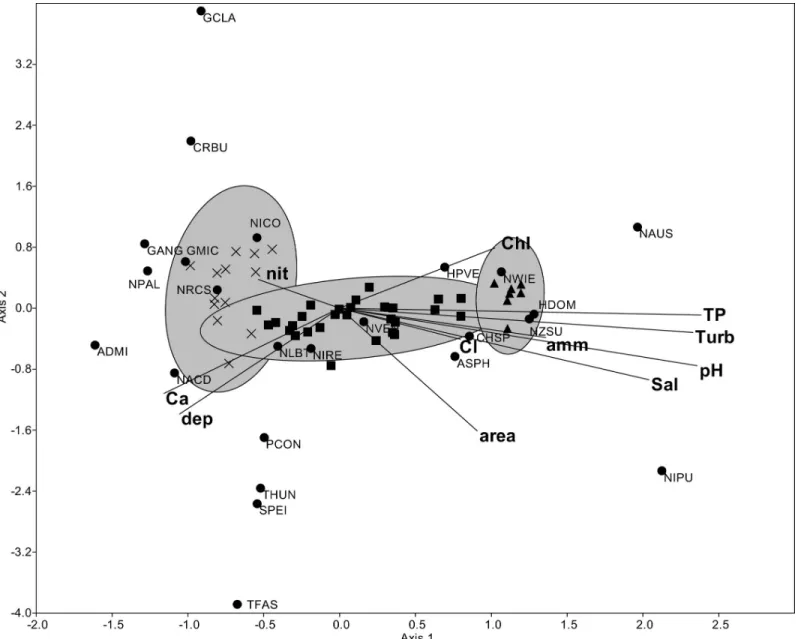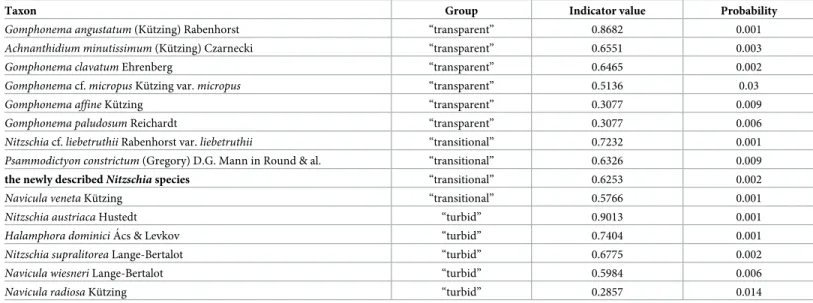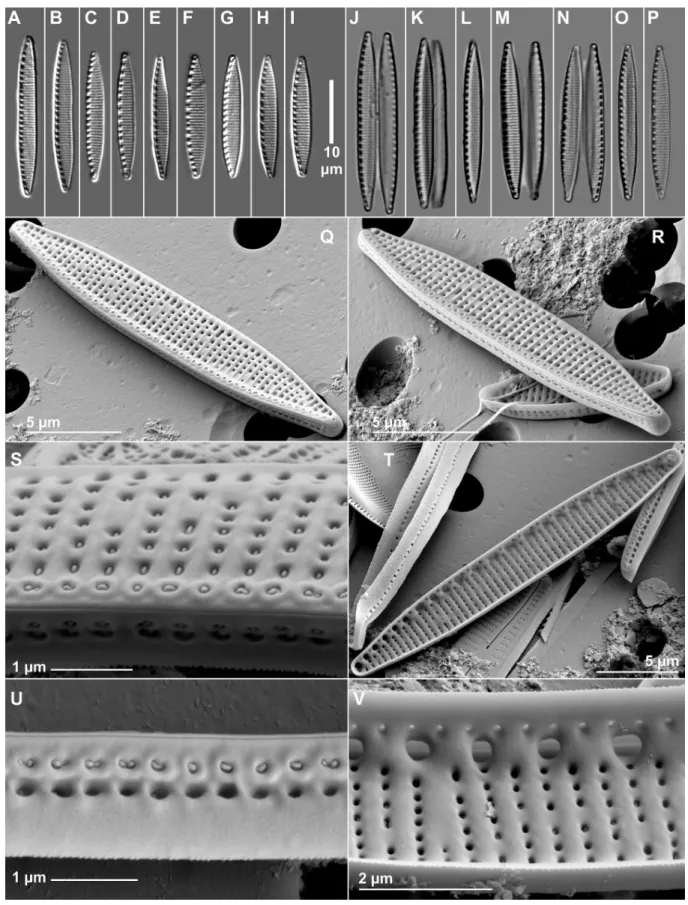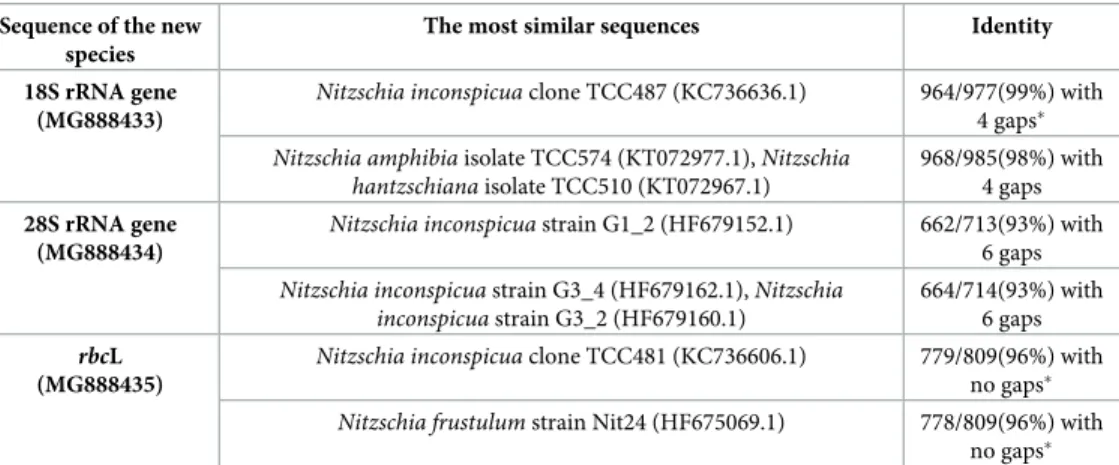Unexpected consequences of bombing.
Community level response of epiphytic diatoms to environmental stress in a saline bomb crater pond area
Ange´la Fo¨ ldi1,2☯, E´ va A´cs3☯, Istva´n Grigorszky3,4, Luc Ector5, Carlos Eduardo Wetzel5, Ga´bor Va´rbı´ro´1,6, Keve Tihame´r Kiss3, Pe´ter Dobosy3, Zsuzsa Tra´bert3, Andrea K. Borsodi3,7, Mo´ nika DulebaID3*
1 MTA Centre for Ecological Research, Sustainable Ecosystems Group, Tihany, Hungary, 2 Doctoral School of Environmental Sciences, Eo¨tvo¨ s Lora´nd University, Budapest, Hungary, 3 MTA Centre for Ecological Research, Danube Research Institute, Budapest, Hungary, 4 University of Debrecen, Department of Hydrobiology, Debrecen, Hungary, 5 Environmental Research and Innovation Department (ERIN),
Luxembourg Institute of Science and Technology (LIST), Belvaux, Luxembourg, 6 MTA Centre for Ecological Research, Danube Research Institute, Department of Tisza River Research, Debrecen, Hungary, 7 Eo¨tvo¨s Lora´ nd University, Department of Microbiology, Budapest, Hungary
☯These authors contributed equally to this work.
*duleba.monika@okologia.mta.hu
Abstract
The spatial response of epiphytic diatom communities to environmental stress was studied in a moderately saline wetland area located in the plain of Danube-Tisza Interfluve, Hun- gary. The area is characterised by World War II bomb crater ponds and can be regarded as an excellent ecological model system where the dispersion of species is slightly limited by distance. To study the effect of environmental variables on the communities, canonical cor- respondence analysis was applied. Salinity, pH, total suspended solids, total phosphorous and depth proved to be significant environmental drivers in this analysis. The ecological sta- tus of the ponds was assessed with Ziemann’s halobity index, as the trophity-depending metric cannot be applied to these habitats (due to the naturally high phosphorus content).
Ponds in “good” ecological status significantly differed from those appertaining to water quality category of “not-good” ecological status considering characteristic of natural astatic soda pans (e.g. salinity, pH, ammonium, total phosphorous concentration, nitrogen:phos- phorous ratio and turbidity). The differences between epiphytic diatom communities inhabit- ing the ponds were detected using non-parametric multidimensional scaling. The samples formed three groups according to the types of ponds (“transparent”, “transitional” and “tur- bid”) based on the width of the macrophyte belt around them. Indicator species related to the ecological status of the ponds and diatom communities contributing to the separation of groups of ponds were identified. One of the indicator species differed from species already described. Light and scanning electron microscopy features and phylogenetic analyses based on three genes (18S and 28S rRNA genes, rbcL) proved that it was a new species of Nitzschia genus, closely related to Nitzschia frustulum and Nitzschia inconspicua. There- fore, description of a new species, Nitzschia reskoi A´ cs, Duleba, C.E.Wetzel & Ector is a1111111111
a1111111111 a1111111111 a1111111111 a1111111111
OPEN ACCESS
Citation: Fo¨ldi A, A´cs E´, Grigorszky I, Ector L, Wetzel CE, Va´rbı´ro´ G, et al. (2018) Unexpected consequences of bombing. Community level response of epiphytic diatoms to environmental stress in a saline bomb crater pond area. PLoS ONE 13(10): e0205343.https://doi.org/10.1371/
journal.pone.0205343
Editor: Suzannah Rutherford, Fred Hutchinson Cancer Research Center, UNITED STATES
Received: February 15, 2018 Accepted: September 24, 2018 Published: October 25, 2018
Copyright:©2018 Fo¨ldi et al. This is an open access article distributed under the terms of the Creative Commons Attribution License, which permits unrestricted use, distribution, and reproduction in any medium, provided the original author and source are credited.
Data Availability Statement: All relevant data are available from the Harvard Dataverse database.
DOI:10.7910/DVN/FGXN5V. Sequences reported in this manuscript have been deposited in the GenBank database under accession numbers MG888433-MG888435.
Funding: This research was supported by the GINOP-2.3.2-15-2016-00019 and National Research, Development and Innovation Office – NKFIH, 119208 grants (https://nkfih.gov.hu/).
proposed. We concluded that the increasing abundance of Nitzschia reskoi was a signal of the degradation of the intermittent saline wetlands.
Introduction
Global warming affects the structure, function and stability of lake ecosystems throughout the world [1]. Small, shallow ponds are especially vulnerable, but the habitat loss due to the con- traction is also detectable in large shallow lakes [1]. In limnological studies, the small, shallow lakes, the intermittent lakes and puddles have not been highlighted against large lakes for a long time. Investigations over the last decades have pointed out that there are significant differ- ences between the ecology of small and large lakes [2,3]. The small lakes are labile because of the low water volume; consequently, they rapidly indicate the change of the environmental conditions (e.g. climate change). Huge numbers of astatic soda pans have decreased during the last decades all over the world, especially in the Carpathian Basin due to human activity and global warming [4].
Saline lakes occur in every continent [5] and the total volume of water in these environ- ments on a global scale nearly equals to that in freshwater lakes [6].
According to the chemical composition, there are two main types of inland high salinity lakes, the salted (dominated by sodium [Na+] and chloride [Cl-] ions) and the soda lakes (dominated by sodium, hydrocarbonate [HCO3-
] and carbonate [CO32-
] ions). They can be also determined based on their hydrological cycles: perennial (or semiastatic) and astatic. Soda lakes are the most stable alkaline environments on Earth [7]. They form in arid and semiarid areas of tropical and subtropical deserts of North America, continental Asia, East African Rift Valley and small areas in Europe such as Kiskunsa´g, in Hungary.
The soda water bodies on the Hungarian Great Plain have alkaline pH and generally lower salt content than seawater and other continental salt waters. The most characteristic ions are the Na+and HCO3-
, the other six ions K+, Ca2+, Mg2+, CO3-
, Cl-, SO42-
and other hydrological features of the soda pans show great variability. The daily changes of water temperature are rather high [8]. Polymixis, hypersalinity and high turbidity are also key factors in these waters [9]. Due to their highly stochastic environmental dynamics, the astatic saline waters have spe- cial but only partially discovered composition of biota. For example, a new trebouxiophycean picoalga (Chloroparva pannonicaSomogyi, Felfo¨ldi & Vo¨ro¨s) was described in 2011 from this special environment, which is not only a new species but belongs to a new genus as well [10].
The winter bloom of picoeukaryotes in Hungarian astatic soda pans also served several unde- scribed species [11,12].
Ecological indicator species are living organisms that are easily monitored and whose status reflects or predicts the condition(s) of the environment where they are found, they have a nar- row tolerance, a well-defined optimum and a high abundance [13]. Currently, benthic diatoms are applied as early warning indicators and signals for ecological problems, and they can serve as barometers for trends in ecological changes. Their usefulness in lentic environments has been already been proven. (e.g. [14–16]).
With the implementation of the European Water Framework Directive and recognition of the conservation values of the intermittent soda pans located in Hungary, a number of studies dealing with their benthic diatoms were published [17–21]. The diatom-based indices for assessing ecological status of the Hungarian astatic soda pans and perennial sodic lakes have been established [22]. However, to define the reference conditions and the effects of natural
Competing interests: The authors have declared that no competing interests exist.
disturbances originated from anthropogenic impacts pose great challenges of the ecological status assessment, especially in these multi-stressed habitats. Here, diatom communities are very special and characteristic [18], frequently dominated by taxa ofNitzschiaHassal genus [23]. Species of the genusNitzschiacan be found in wide range of environments and pollution levels [24] and many of them are important bioindicators (e.g. [25,26]).
The accurate identification of species is important for water quality assessment [27]. The traditional approach for identification of diatoms is morphology-based using the features of their silica frustule. However, it requires trained taxonomists and is often challenged by the influence of life cycle stage and environment on valve morphology [27]. DNA-based methods have become more and more commonly used for improving identification and in biodiversity studies. One of the most crucial elements of these investigations is selecting the appropriate marker [28], which can be used for the identification of species (barcoding markers, [29]). The 18S rRNA gene (e.g. [30]) and 28S rRNA gene (e.g. [28]) andrbcL gene (e.g. [28,31]) are among the most intensively studied and were proposed as barcoding markers.
As a result of mistargeted bombing during the World War II, on some area in Hungary ponds with different diameters and depths were formed in the same time, close to each other.
These habitats are good ecological model systems because the natural environmental stress can be studied, especially since the dispersion of species is slightly limited by distance [32,33].
Our goals were 1) to study the community level response of epiphytic diatoms to natural environmental stress in hyposaline/saline astatic ponds; 2) to examine the applicability of epi- phytic diatoms in assessment of the ecological status of these special temporary wetlands; 3) to define indicator species contributing to the separation of ponds and indicate the good ecologi- cal status of the saline ponds.
One of the indicator species differed from the diatom species already described, therefore, we aimed 4) to provide its exact identification and relationships based on a detailed morpho- logical description using scanning electron microscopy (SEM) and sequence information of three genes (18S rRNA, 28S rRNA andrbcL).
Material and methods Ethics statement
Middle Danube Valley Inspectorate for Environmental Protection, Nature Conservation and Water Management granted the permission (number: KTVF:45737-4/2013) to carry out sam- pling in the area of the Kiskunsa´g National Park, near to the village of Apaj for research purpose.
Study area and sampling
A dense cluster of saline water bomb crater ponds (created by mistargeted bombing of the nearby airport during World War II) is situated in the northernmost part of the Kiskunsa´g National Park (47˚7.403’N 19˚8.187’E), near to the village of Apaj, in the plain of Danube- Tisza Interfluve, Hungary. In an area of approximately 25 hectares (0.25 km2), 112 ponds with various size can be found, from which 48 were studied.
This area has patchy surface salinization, because the flow pattern of groundwater results in extensive surface salinization in those discharge areas where the infiltrating freshwater does not superimpose the upwelling saline water. The salts originate from the overpressured NaCl- type water of the Pre-Neogene basement and the NaHCO3-type water of the Neogene sedi- ments [34]. In these conditons the ponds studied hold sodic water and they can be considered as models of sodic aquatic ecosystems.
As the sampling, the water chemical analysis and the light microscopy (LM) invstigation methods are described in detail in Vad et al. [33] and A´ cs et al. [23], here a short description is provided.
Benthic diatom samples were taken between 7 and 9 May 2014 within the framework of a project that aimed simultaneous sampling and investigation of multiple organism groups (benthic diatoms, zooplankton, macroinvertebrates and vertebrates). During the sampling physico-chemical variables were also measuredin situ(water depth, Secchi depth and diameter of each pond, percentages of open water surface and macrophyte coverage, conductivity, pH and water temperature) or water samples were taken for laboratory analysis (total suspended solids, chlorophylla, total phosphorus, ammonium and nitrate concentrations).
Benthic diatom samples (five replicates per pond) were primarily taken from green com- mon reed (Phragmites australis) stems, or, if it was absent, from alkali bulrush (Bolboschoenus maritimus) or narrowleaf cattail (Typha angustifolia). A 10-cm section of the stems starting at 10 cm below the water surface was cut and and carried to laboratory where epiphyton was washed from stems into tap water using tooth brushes. Diatom frustules were cleaned with hydrogen-peroxide and hydrochloric acid and mounted with Naphrax mountant. Diatoms were identified under Olympus IX70 inverted microscope equipped with differential interfer- ence contrast (DIC) optics at magnification of 1500×.
For description of the newNitzschiaspecies 50 valves were measured and morphologically analysed.
SEM investigations
For SEM observations the cleaned samples were filtered with additional deionized water through a 3-μm Isopore polycarbonate membrane filter (Merck Millipore). Filter was mounted on aluminium stub and coated with platinum using a Modular High Vacuum Coating System BAL–TEC MED 020 (BAL–TEC AG, Balzers, Liechtenstein) or with gold using rotary- pumped spatter coater Quorum Q150R S. Platinum-coated samples were investigated with an ultrahigh-resolution analytical field emission (FE) scanning electron microscope Hitachi SU–
70 (Hitachi High-Technologies Corporation, Japan) operated at 5 kV and SEM images were taken using the lower (SE-L) and upper (SE-U) detector signal. Gold-coated samples were studied with Zeiss EVO MA10 SEM operated at 10 kV.
Culturing and DNA analysis
For culturing, cells of the undescribedNitzschiaspecies were isolated using micromanipulator.
The culture was established and maintained in WC medium [35] prepared from the water sample and incubated at 18˚C with light:dark cycle of 12:12 hours.
The culture was filtered to planktonic mesh with 10μm pore size and shaken into 10 mM Tris-HCl solution and then frozen until processing. To extract DNA, the sample was heated at 95˚C for 15 min, then treated with glass beads using cell mill. After that proteins were digested using Proteinase K (recombinant, Fermentas) at 55˚C for 3 h. From this crude lysate DNA was purified using the DNeasy Plant Mini Kit (Qiagen).
Polymerase chain reactions (PCR) were performed on the 18S rRNA, 28S rRNA andrbcL genes using the primers listed inTable 1. The PCR mixture contained the following compo- nents in the total volume of 25μl: 1.25 U DreamTaqTMDNA Polymerase (Thermo Scientific), 200 mM of each deoxinucleoside triphosphate (Fermentas), 1X DreamTaq Buffer (Thermo Scientific), 0.325μM of each primer, and 1μL of template. The PCR amplifications used the following heat protocol: initial denaturation at 98˚C for 5 min, 32 cycles at 94˚C for 1 min, 52–
60˚C (according to the applied primer pair) for 30 sec, 72˚C for 1–1.5 min (according to the
expected length of the product) and a final extension at 72˚C for 10 min. The sequencing reac- tions and capillary electrophoreses were performed by Biomi Ltd.
The final 18S rRNA gene (983 nt), 28S rRNA gene (708 nt) andrbcL gene (812 nt) sequences assembled from overlapping sequence fragments were searched in the NCBI Gen- Bank using BLAST [38] to find sequences with the highest similarity, and then aligned to sequences downloaded from the database. The ribosomal gene sequences were aligned by sec- ondary structure using the SILVA Incremental Aligner (SINA, [39] available fromhttp://www.
arb-silva.de/aligner/), therbcL sequences were aligned by codon using the Clustal W imple- mented in MEGA 6 [40]. For phylogenetic analysis the substitution model was chosen from the models proposed by MEGA 6 software (‘Find best DNA models’ option) based on the Bayesian Information Criterion. The selected models were the Tamura–Nei model with gamma distribution and invariant sites [41] for 18S and 28S rRNA genes and generalised time-reversible (GTR) model with gamma distribution and invariant sites [42] forrbcL gene.
Bayesian posterior probability of distribution was estimated using the Metropolis–coupled Markov Chain Monte Carlo (MCMC) as implemented in MrBayes 3.2 [43]. Uncorrected p- distance values were calculated with the MEGA 6.
Ecological status assessment
The Hungarian ecological status assessment system uses Ziemann’s halobity index (H, [44]) for the astatic, small soda ponds (that belong to the biological type 3 in the Hungarian vali- dated typology declared at 1155/2016 (III.31) Government decree). The value of the index is converted to a number between 1 and 20 using the following equation:
H¼0:19xþ1
(whereas 1 is the worst, 20 is the best value of the index). Detailed description of the method can be found in A´ cs et al. [22]. The boundary values of the index and Ecological Quality Ratio (EQR) are the followings: poor/bad: 2.7 (EQR: 0.2); moderate/poor: 5.3 (EQR: 0.4); good/mod- erate: 7.9 (EQR: 0.6); high/good: 14.3 (EQR: 0.8).
In the followings we use term “good” for ponds having high and good ecological status from sodic characteristics and “not-good” for ponds not reaching good status (moderate, poor or bad quality categories) that indicates the decreasing of sodic characteristics.
Table 1. Primers used for amplification and sequencing of 18S rRNA andrbcL genes from the undescribedNitzschiaspecies.
Name Marker Sequence (5’ to 3’) Reference
1F1, 2, s 18S rRNA gene AACCTGGTTGATCCTGCCAGT [36]
1528R1 18S rRNA gene TGATCCTTCTGCAGGTTCACCTAC [36]
Nit1113R2, s 18S rRNA gene GGAACCCAAAGACTTGTG This study
DPrbcL11 rbcL AAGGAGAAATHAATGTCT [37]
DPrbcL71, 2 rbcL AARCAACCTTGTGTAAGTCTC [37]
Nit_rbcL583F2, s rbcL GAAGGTTTAAAAGGTGG This study
Nit_lsu41F1, 2, s 28S rRNA gene TAAGCATATAATTAAGCGG This study
Nit_lsu868R2 28S rRNA gene TGTACTCGCACATATG This study
Nit_lsu1068R1, 2, s 28S rRNA gene ACGTCAGAATCGCTAC This study
1primers used in the first PCR
2primers used in the second PCR
ssequencing primers.
https://doi.org/10.1371/journal.pone.0205343.t001
Statistical analysis
The non-metric multidimensional scaling (NMDS) was applied to visualize differences in compo- sition among sites with Bray-Curtis similarity index. The Indicator Species Analysis (IndVal; [45]) based on relative abundance values was applied to identify species that can be used to separate the groups and also to identify the indicator species of ponds having “good” ecological status, the cal- culation was made with ‘labdsv’ package in R environment. SIMPER (Similarity Percentage) method was used for visualising taxa being responsible for the observed difference between groups of samples [46]. The Bray-Curtis similarity measure was used in SIMPER calculation. As the data deviated significantly from normal distribution, Mann-Whitney test was carried out to compare the medians of the environmental and biological variables between the groups.
There was interest in whether the spatial variation or the environmental variables effects more of the diatoms communities, therefore we performed a variation partitioning amongst diatom communities using Moran’s eigenvector maps (MEM). For the MEM analysis ’varpart’
and ’adespatial’ [47] R packages according to suggestions were used [48,49].
The main environmental factors that drive community composition were identified by canonical correspondence analysis (CCA). To reduce the influence of rare taxa, only taxa occurring in at least 10% of studied ponds and having relative abundance minimum 1% in at least one pond (n = 24) were used.
Turbidity, Secchi depth and total suspended solids showed significant correlation (Pearson correlation coefficients were turbidity-total suspended solids: 0.92, Secchi depth-total sus- pended solids: -0.60, Secchi depth-turbidity: -0.64, p<0.05), therefore, only turbidity was used in the further analyses. Area and depth of ponds showed correlations with almost all of other environmental variables including emergent macrophyte coverage.
Relative abundance data were square-root transformed to normalize their distribution and reduce the influence of exceptionally dominant taxa. The environmental variables (except pH) were log transformed to normalize their distribution. The CCA, NMDS SIMPER and the Mann-Whitney test were calculated with software PAST version 3.0 [50].
The ponds were categorized according to the width of the surrounding macrophyte belt as follows:
1. wide (>about 30% of the diameter of pond) 2. narrow (<about 30% of the diameter of pond) 3. absent
Diatom communities were also characterized based on the following biological traits of the occurring species: cell size [51], oxygen requirement [52], nitrogen uptake (N-uptake) strategy [52] and a combined trait. Two traits are frequently used in trait-based studies of benthic dia- toms [53]: i) combined traits and ii) cell size [51]. Furthermore, we considered two other traits, iii) oxygen requirement [52] and iv) N-uptake strategy [52] for the analysis. Values of these traits were obtained from the OMNIDIA 6.0.2 data base [54].
i. Classification into combined trait categories is based on the ability of species to use nutrient resources and to resist to physical perturbation (S1 Table). Practically it is equivalent to adhering strategies of diatoms, and its categories were considered as guilds in the system proposed by Rimet & Bouchez [55] that is a modification of the system by Passy [56].
ii. According to the allometric theory [57], cell size—due to the surface to volume ratio—is the major determinant the specific physiological activities of algae [58] such as growth, nutrient uptake and light capture.
iii. Oxygen is produced by photosynthesis, the rate of which—and thus the oxygen produc- tion—is influenced by light, temperature and nutrient levels. In light-limited habitats dia- toms may rely on heterotrophic metabolism [59] becoming oxygen consumer from producer. The used classification of oxygen requirements is based on the oxygen concen- tration of waters that species can tolerate [52].
iv. iv) Several studies have shown that diatoms are able to assimilate organic nitrogen com- pounds (e.g. [60]). The ability of heterotrophic nitrogen-uptake serves as an additional source of nitrogen for diatoms, particularly under nitrogen-poor conditions, which may occur in soda waters [61]. The sensitive nitrogen-autotrophic taxa can tolerate only very small concentrations of organically bound nitrogen, the tolerant nitrogen-autotrophic taxa can tolerate elevated concentrations of organic nitrogen. The facultative nitrogen-hetero- trophic taxa need periodically elevated concentrations, while the obligate nitrogen-hetero- trophic taxa need continuously elevated concentrations of organic nitrogen [52].
The species distribution is shown on a sketch map of Hungary prepared using the ESRI ArcView 10.2 GIS program.
Nomenclature
The electronic version of this article in Portable Document Format (PDF) in a work with an ISSN or ISBN will represent a published work according to the International Code of Nomen- clature for algae, fungi, and plants, and hence the new names contained in the electronic publi- cation of a PLOS ONE article are effectively published under that Code from the electronic edition alone, so there is no longer any need to provide printed copies.
The online version of this work is archived and available from the following digital reposi- tories: PubMed Central, LOCKSS.
Results
Physical-chemical and benthic diatom-based biological features of the ponds
The ponds showed considerable variation in their physical-chemical properties (Table 2). All of them were alkaline, their trophic conditions varied from oligotrophic to hypertrophic. The salinity of the ponds varied from 0.97 to 5.5 g L-1, the Secchi transparency and turbidity varied in large intervals, the electric conductivity was 3.4 mS cm-1in average (Table 2).
The differences in physical and water chemical variables enabled different benthic diatom communities to develop in the ponds. The NMDS showed that the ponds formed three distinct groups (Fig 1). The results of the NMDS met to the macrophyte belt categories for this study:
1: ponds with wide macrophyte belts, are refered to as “transparent” group (Part A inS1 Fig);
2: ponds with narrow macrophyte belts, are refered to as “transitional” group (Part B inS1 Fig); 3: ponds without macrophyte belts, are refered to as “turbid” group (Part C inS1 Fig).
There was no systematic spatial pattern in the physical-chemical variables of the ponds belonging to different groups, and the diatom composition was also quite different (Fig 2), as they exhibited mosaic-like arrangements.
The effect of spatiality was tested with Moran’s eigenvector maps (MEM) analysis, which shows that the spatial component compared to the environmental parameters has a negligible effect of the studied diatoms communities. (Env adj R2: 0.401. compared to Space adj. R2: 0.018).
The “transparent” group contained the ponds having low salinity, pH, TP and high trans- parency (Table 2). These ponds had the smallest area, and they were surrounded with wide macrophyte belt. The “transitional” group included the ponds having higher salinity, pH, TP,
nitrate and ammonium content but moderate transparency (moderate suspended matter con- tent). The “turbid” group involved ponds having the highest salinity, pH, TP, turbidity, ele- vated chlorophyllacontent and they have the largest area.
Table 2. Mean and ranges values of the environmental variables recorded in three groups of the 48 investigated bomb crater ponds.
Environmental variables Abbr. on figs and in text
Mean (min-max) in "transparent"
group
Mean (min-max) in "transitional"
group
Mean (min-max) in "turbid"
group
Area (m2) 29.8 (7.1–50.2) 42.5 (12.6–70.8) 60.6 (28.3–86.5)
Depth (cm) dep 33.9 (15–53) 41.2 (14–60) 24.6 (4–38)
Salinity (g L-1) Sal 1.7 (1.0–2.5) 2.8 (1.4–4.0) 3.4 (2.9–3.8)
Electric conductivity (mS cm-1) 2.2 (1.2–3.3) 3.6 (1.8–5.1) 4.4 (3.8–4.9)
pH 8.1 (7.8–8.4) 8.5 (8.0–9.0) 8.7 (8.2–9.0)
Secchi depth (cm) 26.1 (15–53) 17.6 (4–50) 8.4 (4–15)
Turbidity (NTU) Turb 28.9 (4.8–97.0) 124.8 (22–691) 245.7 (72–539)
Total suspended solids (mg L-1) TSS 27.8 (6.8–91.2) 83.5 (14.2–372) 143.9 (64.3–388)
Total phosphorus (μg L-1) TP 91.7 (32.7–221.2) 213.4 (45.2–690.3) 838.0 (255.0–1693.6)
Chlorophylla(μg L-1) Chl 10.2 (4.9–14.3) 32.7 (0–387.6) 34.5 (8.8–131.4)
Nitrate-N (mg L-1) nit 0.35 (0.13–0.83) 0.36 (0.15–0.73) 0.21 (0.13–0.32)
Ammonium-N (mg L-1) amm 0.11 (0.01–0.35) 0.37 (0.01–3.51) 0.37 (0.03–1.01)
Open water surface (%) 73.2 (40–96) 89.6 (50–99.5) 91.3 (80–99)
Submerged macrophyte coverage (%)
0.1 (0–1) 1.3 (0–20) 0.6 (0–3)
Emergent macrophyte coverage (%)
26.8 (3–60) 9.1 (0.5–50) 6.7 (1–10)
https://doi.org/10.1371/journal.pone.0205343.t002
Fig 1. Non-metric multidimensional scaling (NMDS) ordinations of diatom communities. The marks indicate the macrophyte belt categories: cross = “transparent”
group, filled square = “transitional” group, filled triangular = “turbid” group.
https://doi.org/10.1371/journal.pone.0205343.g001
Ecological status of ponds based on benthic diatoms
Of the 48 studied ponds 18 were in good or high status based on benthic diatoms (S2 Table).
The majority of the ponds having “good” status (11) belonged to the “transitional” group, the remaining belonged to the “turbid” group. Almost every pond belonging to the “turbid” group was in “good” status.
According to the Mann-Whitney test the salinity, pH, ammonium, TP, nitrogen:phospho- rous (N:P) ratio and turbidity differed significantly between ponds in “good” and in “not- good” status (Fig 3), other measured chemical variables showed no significant differences.
Turbidity, pH, salinity, total phosphorous and ammonium ion content were higher in ponds in “good” status, however, the N:P ratio was lower than in ponds in “not-good” status. The rel- ative abundances of motile or adnate diatoms having micro (100�300μm3) cell size, moder- ate oxygen requirements and heterotrophic N-uptake strategy (facultative or obligate) were significantly higher in ponds in “good” status. The relative abundances of polyoxybiont, sensi- tive N-autotrophic, erected diatoms with meso (300�600μm3), macro (600�1500μm3) and large (>1500μm3) cell size were significantly higher (Fig 4) in ponds in “not-good” status.
Ponds in “good” status had significantly higher area (Fig 5), however, they were exposed strongly to the wind (they were surrounded by no or just narrow macrophyte belt).
Main drivers of the diatom composition
Altogether 80 diatom taxa, representing 33 genera, were found in this study. All taxa were identified to species level with the exception of four taxa. The three taxa were identified to genus level. The group of centrics were treated separately because it contained small, planktic
Fig 2. Location of the ponds in latitude-longitude coordinate system. The marks indicate the macrophyte belt categories: cross = “transparent” group, filled square =
“transitional” group, filled triangular = “turbid” group.
https://doi.org/10.1371/journal.pone.0205343.g002
organisms that were difficult to identify under light microscope. This group occurred only in one sample in a small amount. Twenty-four species were dominant (their relative abundance reached 5% in at least one sample) in the ponds (S3 Table). In the “transparent” group the genusGomphonemahad the highest proportion, it was followed by the genusAchnanthidium, while in the “transitional” and “turbid” groups the generaHalamphora,NaviculaandNitzschia dominated the epiphyton (Fig 6). The frequency of the most dominant species exceeded 20%
(it means that they occurred in more than ten ponds). In addition, the following species had more than 20% frequency:Anomoeoneis sphaerophora(Ehrenberg) E.Pfitzer,Craticula ambi- gua(Ehrenberg) D.G.Mann,Nitzschia commutataGrunow in Cleve & Grunow,Nitzschia vitreaNorman,Pseudofallacia monoculata(Hustedt) Yan Liu, Kociolek & Quanxi Wang. The most frequent species wereNavicula venetaKu¨tzing and an unidentifiedNitzschiaspecies occurring in every studied pond. The mean of their relative abundances reached the highest values in the “transparent” group.
Salinity, pH, TSS, TP and depth all proved to be significant environmental drivers of the community composition based on the CCA analysis.Halamphora dominiciA´ cs & Levkov, Nitzschia pusilla(Ku¨tzing) Grunow emend Lange-Bertalot,Nitzschia austriacaHustedt and Nitzschia supralitoreaLange-Bertalot were positively correlated with salinity, pH, TSS and TP, whileCraticula accomoda(Hustedt) Mann andPsammodictyon constrictum(Gregory) D.G.
Mann in Round & al. with water depth.Achnanthidium minutissimum(Ku¨tzing) Czarnecki, Gomphonema angustatum(Ku¨tzing) Rabenhorst andNitzschia palea(Ku¨tzing) W.Smith var.
paleaproved to be exceptionally dominant in waters with low salinity, pH, TP and TSS values (Fig 7).
Indication
The IndVal analysis identified 15 indicator species with significant indicator values for the bomb crater ponds (Table 3); six of them belonged to the “transparent”, four to the “transi- tional” and five to the “turbid” groups.
The Indicator Species Analysis also showed that four species namelyHalamphora dominici, Navicula wiesneriLange-Bertalot,Nitzschia austriaca,Nitzschia supralitoreaindicated “good”
ecological status (in SIMPER analysis they showed 3.5–25.5% contribution), while nine species were significantly related to the “not-good” status. The latter ones wereAchnanthidium minutis- simum,Craticula buderi(Hustedt) Lange-Bertalot,Gomphonema angustatum,Gomphonemacf.
micropusKu¨tzing,Gomphonema clavatumEhrenberg,Nitzschia acidoclinataLange-Bertalot, Nitzschia commutata,Nitzschia palea(Ku¨tzing) W.Smith var.paleaandPsammodictyon con- strictum(they showed 0.117–23% contribution in SIMPER analysis). The newly described Nitzschiaspecies was not an indicator species in ponds in “good” or ponds in “not-good” status.
Identification of the newNitzschiasp
Based on the IndVal Analysis, one of the indicator species of the “transitional” group was a Nitzschiaspecies that we could not identify exactly with LM. Therefore, a detailed SEM study was performed on it. It differed from other known diatoms in micromorphological features.
Therefore, a pure culture has been established, and sequence analysis of three different DNA regions was carried out.
Fig 3. Box-plots showing the physical and chemical differences between the ponds in “good” and “not-good” ecological status. All differences were significant. Lines represent the medians, boxes represent the interquartile ranges (25–75%), whiskers represent 1.5 interquartile ranges, stars and circles represent outliers. A: ammonium ion concentration (mg L-1), B: nitrogen:phosphorous ratio, C: total phosphorous (mg L-1), D: pH, E:
salinity (g L-1), F: turbidity (NTU). I = “good”, II = “not-good”.
https://doi.org/10.1371/journal.pone.0205343.g003
Microscopical investigations. The shape of valves is lanceolate with slightly protracted, narrow apices ends (Fig 8A–8P). Transapical striae are visible and the areolae can be resolved in LM. The fibulae are regularly distributed along the raphe canal. SEM features externally: the
Fig 4. Box-plots showing the differences between relative abundances of categories of traits found in the ponds in “good” and “not-good” ecological status. A:
combined trait, B: cell size, C: oxygen requirement, D: nitrogen uptake strategy. Within each traits a: significant, b: non-significant differences. Lines represent the medians, boxes represent the interquartile ranges (25–75%), whiskers represent 1.5 interquartile ranges, stars and circles represent outliers. I = “good”, II = “not-good”.
https://doi.org/10.1371/journal.pone.0205343.g004
striae are uniseriate, both on the valve face and within the raphe canal, where each stria is rep- resented by a single areola. The areolae are generally circular, sometimes irregular, some of them missing and the last areola is transapically elongated near the margin, opposite to raphe canal (Fig 8Q and 8R). Every first areolae near the raphe canal have a thickened ring around them. On the mantle, the striae are very short, comprising two areolae (Fig 8S and 8U), one of them cannot internally be detected. Raphe is continuous. Distal raphe fissures hooked (Fig 8Q and 8R). Internal distal raphe endings terminating in helictoglossae (Fig 8T). Internally, canal raphe subtended by fibulae widening to the valve face to form round portulae. Fibulae more or less evenly spaced throughout the valve, their shape is rectangular, one fibula is connected to two-three striae (Fig 8T). The raphe slit is uninterrupted, so it has no central nodule (Fig 8V).
Fig 5. Box-plots showing the area differences of ponds in “good” and “not-good” ecological status. The difference was significant. Lines represent the medians, boxes represent the interquartile ranges (25–75%), whiskers represent 1.5 interquartile ranges. I = “good”, II = “not-good”.
https://doi.org/10.1371/journal.pone.0205343.g005
DNA analysis. According to the BLAST search, sequences of our taxon showed the high- est similarity with the species ofNitzschiasection Lanceolatae:Nitzschia inconspicuaGrunow, N.amphibiaGrunow,N.hantzschianaRabenhorst,N.frustulum(Ku¨tzing) Grunow in Cleve
& Grunow (Table 4). These species are among the taxa to which the new species is morpholog- ically the most similar.
On the 18S rRNA gene based phylogenetic tree (Fig 9) the new taxon formed a clade with Nitzschia inconspicua,N.amphibia,N.hantzschiana, andDenticula kuetzingiiGrunow, how- ever, the former two species did not seem to be monophyletic. The former species grouped together with a monophyletic clade of the isolates ofN.supralitoreaand formed the sister group ofFragilariopsisandPseudo-nitzschia.Nitzschia liebetruthiiRabenhorst var.liebetruthii as well asNitzschia frustulumandN. cf.frustulumwere located in the next two lineages.
On therbcL gene based tree (Fig 10) the new species was located in a clade formed by grade of lineages containingN.amphibia,D.kuetzingii,N.inconspicua,N.supralitorea,N. cf.buln- heimiana(Rabenhorst) H.L.Smith,N.frustulumandN. cf.aequoreaHustedt. This clade was the sister group ofFragilariopsisandPseudo-nitzschia.Nitzschia frustulumandN. cf.frustulum were placed in the next lineage, whileN.liebetruthiiwas more distantly located.
On the 28S rRNA gene based tree (Fig 11) the clade containing the new species involved the isolates ofN.frustulum,N.inconspicua,N.supralitorea,N.amphibia,N. cf.aequorea,N. cf.
microcephalaGrunow,N. cf.pusilla,N. cf.frustulum. This was the sister group of the clade of N.fonticolaGrunow/cf.fonticolaandN.soratensisE.Morales & M.L.Vis strains. The group includingFragilariopsisandPseudo-nitzschiaamong others was more distantly related. The 28S rRNA gene sequence ofN.liebetruthiiwas not available.
The uncorrected p-distance was calculated between the studied taxon and the morphologi- cally most similar taxa. The distance was the highest in 28S rRNA and the lowest in 18S rRNA genes (Table 5). In case of 18S rRNA andrbcL genes, the comparison was carried out both on whole stretch and on the region proposed as barcode by Zimmermann et al. [30] and Hamsher et al. [28], respectively. The p-distance values were lower in the whole length than in the bar- code region (ourrbcL gene sequence was not fully overlapped with therbcL-3P proposed by Hamsher et al. [28], the compared region was 731 nt instead of 748 nt).
Fig 6. The proportion of the relative abundances of the dominant diatom genera in the three groups.
https://doi.org/10.1371/journal.pone.0205343.g006
Discussion
Physical-chemical and benthic diatom-based biological features of the ponds
The bomb crater ponds are situated in the plain of Duna-Tisza Interfluve. This area is charac- terized by mosaic pattern of Solonchak (characterized by accumulation of water-soluble sodium salts mainly in the upper zones and uniform section construction without recognizable levels, [62,63]) and Solonchak-Solonetz (with accumulated water-soluble sodium salts but hav- ing definitely recognizable levels, [62,63]) soils and halophyte vegetation. In this section two groundwater flow domains were identified: a gravity-drive meteoric fresh water and an over-
Fig 7. Canonical correspondence analysis showing the relationships between the relative abundances of the dominant diatom taxa and the environmental variables plotted with 95% ellipses. Environmental variables are indicated with lines, while species are indicated with points. Cross = samples from “transparent”, filled square = “transitional” and filled triangular = “turbid” ponds. The percentage of explained variance of axis 1 is 56.02 and that of axis 2 is 12.85. ASPH =Anomoeoneis sphaerophora, CHSP =Chamaepinnulariasp., NICO =Nitzschia commutata, NPAL =Nitzschia palea(Ku¨tzing) W.Smith var.palea, SPEI =Surirella peisonisPantocsek.
See other abbreviations inS2andS3Tables.
https://doi.org/10.1371/journal.pone.0205343.g007
pressured deeper domain of saline water [64]. The groundwater level is close to the soil surface (in not more than 1 m depth) and the total dissolved salt content is high (reaches the 5000 mg L-1, [65]). This water causes extensive surface salinization in those discharge areas where the infiltrating freshwater does not superimpose the upwelling saline water. Where a freshwater lens is located above the ascending saline water, this fresh gravity-driven flow controls the sur- face distribution of salts, resulting in a mosaic pattern in the chemical variables of the surface waters beside the variation of the soil and vegetation [34].
The studied bomb craters were bordered by macrophyte belts with various widths. Based on the diatom community composition, these ponds can be rated to three types corresponding to the width of the macrophyte belt. The ponds in the “transparent” group are characterized by small water surface and broad macrophyte belt. Therefore these ponds are rarely stirred up by the wind, thus their water is transparent. The ponds in the “transitional” group have relatively large water surface and narrow marcophyte belt, hence the wind can occasionally mix them up. The ponds in the “turbid” group do not have macrophyte belts at all, their water can be stirred up by the weakest wind, so they are turbid. Regarding their physical and chemical char- acteristics these turbid ponds are the most similar to the soda pans of the Carpathian Basin [4].
Ecological status of ponds based on benthic diatoms
Diatoms are widely used organisms to monitor environmental changes, because they respond to the changes of conductivity and ionic composition as well [66]. They are frequently used as ecological indicators not only in lotic but in lentic environments as well (e.g. [15,67]). Previ- ously, the usefulness of diatoms as indicator of nutrients was investigated in many studies [68–
71,16]. In case of soda ponds, the metrics indicating the changes of salt content acquire more increased role. The physical and chemical properties of the saline wetlands (e.g. pH, ionic com- position, nutrient availability and light) are influenced not only by anthropogenic but also nat- ural processes [4]. The soda pans are very important cross-continental migrating and breeding sites for aquatic birds, so they have naturally high nutrient content [61]. Therefore, trophity metric cannot be applied in case of these ponds. So, a metric which indicates the changes of the salt content had to be chosen. While increasing salt content indicates adverse processes in most water types, in soda pans the disappearance of soda character is unfavourable [22]. The
Table 3. The most significant indicator species based on IndVal.
Taxon Group Indicator value Probability
Gomphonema angustatum(Ku¨tzing) Rabenhorst “transparent” 0.8682 0.001
Achnanthidium minutissimum(Ku¨tzing) Czarnecki “transparent” 0.6551 0.003
Gomphonema clavatumEhrenberg “transparent” 0.6465 0.002
Gomphonemacf.micropusKu¨tzing var.micropus “transparent” 0.5136 0.03
Gomphonema affineKu¨tzing “transparent” 0.3077 0.009
Gomphonema paludosumReichardt “transparent” 0.3077 0.006
Nitzschiacf.liebetruthiiRabenhorst var.liebetruthii “transitional” 0.7232 0.001
Psammodictyon constrictum(Gregory) D.G. Mann in Round & al. “transitional” 0.6326 0.009
the newly describedNitzschiaspecies “transitional” 0.6253 0.002
Navicula venetaKu¨tzing “transitional” 0.5766 0.001
Nitzschia austriacaHustedt “turbid” 0.9013 0.001
Halamphora dominiciA´ cs & Levkov “turbid” 0.7404 0.001
Nitzschia supralitoreaLange-Bertalot “turbid” 0.6775 0.002
Navicula wiesneriLange-Bertalot “turbid” 0.5984 0.006
Navicula radiosaKu¨tzing “turbid” 0.2857 0.014
https://doi.org/10.1371/journal.pone.0205343.t003
Fig 8. LM (A-P) and SEM (Q-V) micrographs of the new taxon isolated from Apaj.
https://doi.org/10.1371/journal.pone.0205343.g008
diatom communities of the bomb craters showed high similarity to those natural astatic soda ponds belonging to the biological type 3 according to the Hungarian typology [33]. Hence we performed water quality assessment according to this type. In the studied area, no anthropo- genic intervention has happened since the World War II bombing. So, primarily the ponds belonging to the “turbid” group can be model sites for the shallow, astatic soda lakes. The results may be useful to aid the design of soda pan restoration plans in order the soda pans to achieve the “good” ecological status corresponding to requirements of the Water Framework Directive. During their conservation, it should be managed to maintain those salinity levels that sustain their species composition, diversity and productivity. On the basis of the applied halobiont evaluation system we could distinguish the anthropogenic impact from the natural processes.
Main drivers of the diatom composition
Altogether 80 diatom taxa, representing 33 genera, were found in our study, which is a rela- tively high number in such small and saline waters such as these bomb crater ponds. Bolgovics et al. [72] clearly demonstrated that the small aquatic pools can also serve favorable environ- ments for high species richness which draws attention to the conservation biological impor- tance of the small habitats, as well. According to Legler & Krasske [73], the diatom species composition of Van Lake was very similar to the Hungarian soda pans studied by Cholnoky [74] and the soda lakes of Burgenland studied by Legner [73].
The CCA was performed in order to assess the main environmental drivers forming the structure and the composition of diatom communities in the studied small soda ponds. The most significant variables were the salinity (and also the conductivity), pH, turbidity (and also the TSS and Secchi transparency), TP and depth. Schagerl et al. [75] found that sodium, pH and dry mass significantly contributed to the phytoplankton taxa pattern in two Kenyan soda lakes. Salinity and trophic status were found as the most important environmental variables affecting the composition of the local biota [76], while the temperature, pH, oxygen saturation, ionic composition and salinity were the main environmental variables determining the diatom composition in soda pans of the Carpathian Basin [18,20]. Our results suggest that the salinity,
Table 4. The results of the BLAST search.
Sequence of the new species
The most similar sequences Identity
18S rRNA gene (MG888433)
Nitzschia inconspicuaclone TCC487 (KC736636.1) 964/977(99%) with 4 gaps� Nitzschia amphibiaisolate TCC574 (KT072977.1),Nitzschia
hantzschianaisolate TCC510 (KT072967.1)
968/985(98%) with 4 gaps 28S rRNA gene
(MG888434)
Nitzschia inconspicuastrain G1_2 (HF679152.1) 662/713(93%) with 6 gaps Nitzschia inconspicuastrain G3_4 (HF679162.1),Nitzschia
inconspicuastrain G3_2 (HF679160.1)
664/714(93%) with 6 gaps rbcL
(MG888435)
Nitzschia inconspicuaclone TCC481 (KC736606.1) 779/809(96%) with no gaps� Nitzschia frustulumstrain Nit24 (HF675069.1) 778/809(96%) with
no gaps� The table shows the records that reached the two highest maximum scores. Identity is expressed in the rate of the identical sites to the compared sites.
�Comparisons in which our sequence could not be fully aligned to that in the database (coverage = 99%).
NCBI GenBank accession numbers are in brackets.
https://doi.org/10.1371/journal.pone.0205343.t004
Fig 9. Bayesian inferred phylogenetic tree based on 18S rRNA gene sequences. For clarity certain clades were collapsed to triangles.
Posterior probability values are indicated at the nodes. Sequence acquired in this study is indicated with bold letters. Scale bar: 0.06 substitutions/site.
https://doi.org/10.1371/journal.pone.0205343.g009
Fig 10. Bayesian inferred phylogenetic tree based onrbcL sequences. For clarity certain clades were collapsed to triangles. Posterior probability values are indicated at the nodes. Sequence acquired in this study is indicated with bold letters. Scale bar: 0.05 substitutions/site.
https://doi.org/10.1371/journal.pone.0205343.g010
Fig 11. Bayesian inferred phylogenetic tree based on 28S rRNA gene sequences. For clarity certain clades were collapsed to triangles. Posterior probability values are indicated at the nodes. Sequence acquired in this study is indicated with bold letters. Scale bar: 0.1 substitutions/site.
https://doi.org/10.1371/journal.pone.0205343.g011
pH and turbidity (caused by the wind which can frequently resuspend the small particles of the soil) are the main stress factors and they are the most important environmental variables shaping the diatom communities in these bomb crater ponds.
On the basis of the diatom community composition the ponds could be divided into three distinct groups and the physical-chemical variables also markedly differed in these groups.
The ponds of the “turbid” group showed the most soda features since they are characterized by high pH, conductivity, TP and TSS. The N:P ratio was very low (<1), caused by high pH, simi- larly to several other Hungarian soda pans [61]. The genusNitzschiawas represented (first of all in the “turbid” group) by the greatest number of species (16), and then the genusGompho- nema(dominated the “transparent” group) had the second largest number of taxa (9).
Nitzschiaspecies were most frequent in the saline lakes of Danube-Tisza Interfluve and Fertő- Hansa´g region, as well [18], and it was represented by the greatest number of species also in Mono Lake (California, USA) [77]. The dominance of the genusNitzschiacan be related to the high turbulence rates [78], and it was abundant in those ponds where the algae had to cope with physical stress caused by the wind-induced turbulences. Beside theNitzschiataxa, the genusHalamphorawas subdominant in “turbid” group. Probably theHalamphoraspecies are shade-tolerant taxa, similarly toAmphoraspecies [79].Nitzschiataxa are also shade-tolerant and they are capable of feeding in heterotrophic manners [80]. In the “transparent” group the proportion of genusGomphonemawas the highest, followed by the genusAchnanthidium.
They can attach in prostrate form to the substrate. In a mesocosmos experiment, the relative abundance ofAchnanthidium minutissimumdecreased with increasing of salinity [81]. Sites with low sodium ion content were characterised by high relative abundance ofGomphonema species in a study on epiphytic diatoms of three temporary depressional wetlands in South Africa [82].
Among the frequent species in the studied bomb crater ponds,Anomoeoneis sphaerophora is a worldwide distributed diatom in inland saline waters [83–88] (and it was an indicator spe- cies of Fertő-Hansa´g soda pans [18]).Nitzschia vitreawas occurred e.g. in Lake Van [68], Lake Chad area [84], Baltic Sea [89] and some soda pans of the Carpathian Basin [19].
Gomphonema jadwigiaeLange-Bertalot & E. Reichardt was dominant only in one pond (relative abundance 8.9%), and occurred in two other ponds but only in a few number. The species was described in 1996 as an oligotrophic indicator species [90]. We found it in three hypertrophic ponds (the total phosphorus concentrations were above 100μg L-1, which is the
Table 5. Uncorrected p-distance values (expressed in percentage) calculated between the new species and the taxa morphologically most similar to it.
Species 18S rRNA gene V4 region� 28S rRNA gene rbcL rbcL-3P��
Nitzschia amphibia 2.76 (27) 5.90 (22) - 6.70 (25) 17.28 (89) 7.88 (64) 8.34 (61)
Nitzschia bulnheimiana - - - 4.68 (38) 4.51 (33)
Nitzschia frustulum 7.19 (70) - 7.43 (72) 10.81 (40) -12.57 (46) 12.83 (48)– 15.64 (81) 3.94 (32) - 9.01 (73) 3.69 (27) - 9.71 (71)
Nitzschia hantzschiana 2.25 (22) 4.55 (17) - - -
Nitzschia inconspicua 1.85 (18) - 2.82 (24) 4.01 (15) - 5.88 (22) 8.70 (58)– 17.59 (102) 3.94 (32) - 6.16 (50) 3.83 (28) - 6.29 (46)
Nitzschia liebetruthii 6.81 (66) 11.08 (41) - 10.84 (88) 11.08 (81)
Nitzschia supralitorea 5.17 (44) 7.8 (29) 18.06 (95) - -
The numbers of different sites are in brackets.
�This comparison was limited to the region that was proposed as barcode by Zimmermann et al. [30]. The analysis also included 18S rRNA gene sequence (FR873260.1) ofNitzschia inconspicuafrom Zimmermann et al. [30].
��This comparison was limited to the region that was proposed as barcode by Hamsher et al. [28]. The analysis also includedrbcL sequence (HQ337571.1) ofNitzschia frustulumstrain CCMP558 from Hamsher et al. [28].
https://doi.org/10.1371/journal.pone.0205343.t005
limit of hypertrophic conditions [91], all of them were subsaline (2–2.8 g L-1) according to the Hammer’s [9] categorization and belonged to the “transparent” group.Gomphonema jadwi- giaeis a rare species worldwide. It was noted as an “interesting record” in the monitoring of benthic diatoms of lakes in Brandenburg [92]. It was also found in Lake Dojran and River Var- dar (Republic of Macedonia), both localities are eutrophic with medium to high electrolyte content [93].
Indication
The indicator species of the “transparent” group mostly belong to the high profile guild, first theGomphonemaspecies which prefer the low disturbance [56].Navicula venetawas the most dominant diatom among the indicator species of the “transitional” group. The high percentage of the alkaliphilicNavicula venetawas also observed in shallow Seewinkel soda pans (Austria) by Yoshitake & Fukushima [94].
Halamphora dominiciwas one of the most dominant, frequent species and indicator of the
“turbid” group in our study, which occurred in pristine, saline environments [95]. It was described from a turbid Bolivian high-mountain shallow lake with high salinity, but nowadays frequently reported from soda pans of the Carpathian Basin [19], and it is regarded as an indi- cator species for reference sites of soda pans of Fertő-Hansa´g region [20]. Among our indica- tor species of the “turbid” group,Nitzschia austriacais a characteristic indicator species of soda waters, including the protected astatic soda pans [23].Nitzschia supralitoreawas found in 23 soda pans of the Carpathian Basin, generally as a dominant species [19].Navicula wiesneri was found in four soda pans of the Carpathian Basin, sometimes as a dominant species [19]
and we found it as indicator species of “good” ecological status in bomb crater ponds.
The mean of the relative abundance of the newly describedNitzschiaspecies was the highest in the “transitional” groups, and it contributed greatly (with 11.2%) to the separation of
“good” and “not-good” ecological status according to the SIMPER analysis, so we presume that the increasing abundance of thisNitzschiaspecies is a signal of the degradation of the intermittent saline wetlands.
Identification of theNitzschiasp
In spite of the increasing number of publications dealing with the benthic diatoms of the Hun- garian astatic soda pans [17–21], one of the most common (sometimes dominant)Nitzschia species has not been identified correctly yet. Therefore, we isolated it and performed sequence analysis and a detailed microscopic investigation. The newNitzschiaspecies differs fromN.
alpinaHustedt emend. Lange-Bertalot,N.amphibia,N.annewillemsianaHamsher, Kopalova´, Kociolek, Zidarova & Van de Vijver,N.bulnheimiana,N.costeiTudesque, Rimet & Ector,N.
frustulum,N.frustulumvar.salinaHustedt,N.hantzschianaandN.inconspicuafirst of all in the absence of central nodule (Table 6).Nitzschia kahliiLange-Bertalot & Rumrich is smaller than the newNitzschia.Nitzschia perminuta(Grunow) Peragallo has double-quadruple areolae at the raphe keel. One fibula is connected to one costa inN.supralitoreaandN.solitaHustedt while two to three striae in the newNitzschia.Nitzschia liebetruthiias observed from the mate- rial N˚1253 (Miramar (Venezia Giulia)—Italy, "Nitzschia liebetruthii Grun.et Rabh.Collectio Grunow 1253 'Nitzschia liebetruthii Nitzschia perpusilla',in envelope Acqu.1901/1063") bor- rowed at the Grunow Collection (David Mann, personal communication) contain cells that are typically lanceolate with the raphe interrupted at the central nodule.Nitzschia liebetruthii cells are linear-lanceolate to lanceolate and larger cells are slightly flexed (as might be expected in post-initial cells) thus slightly constricted in larger frustules. The newly describedNitzschia species closely resemblesNitzschia frustulum, which is regarded as an extremely salt tolerant

